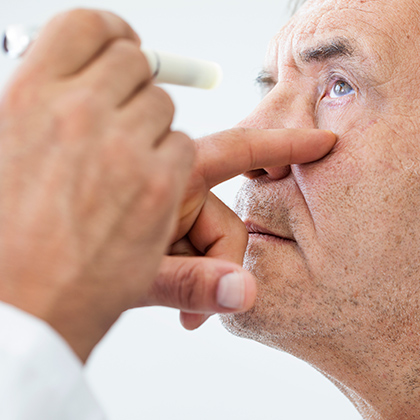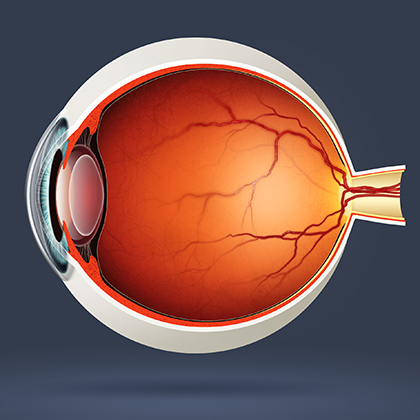
As most people’s eyesight changes with age, it natural as we get older to become more concerned about keeping our eyesight healthy. And even if you had 20:20 vision as a young adult, you may well have started to notice your vision becoming a little less perfect with each passing year.
Presbyopia is a condition that affects your near vision is one of the many ways ageing can affect the eyes, and most people start noticing the signs of it by the time they reach their forties. This loss of near focusing ability that makes seeing things close up more difficult is also called age-related long sight.
But while it’s often an annoying part of ageing, it’s perfectly normal and natural. It’s very common too, with estimates suggesting there were 1.8 billion people globally with presbyopia in 2015.i
What causes presbyopia?
Presbyopia happens when the lenses in your eyes become stiffer and less elastic. In its normal resting position, the lens naturally focuses on objects in the distance. To focus on something close up, however, it has to change shape to become more thickened and curved. If you have normal eyesight this isn’t a problem when you’re a child or young adult, as at that age the lens changes shape easily.
As you get older the lens starts to become stiffer, and the muscles surrounding it that help it change shape, and have to work harder to compensate. But in time these muscles become less and less effective, making the lens completely unable to focus on near objects – which means your close-up vision becomes blurred.

This typically presents problems such as difficulties reading small print. Some of the other things you may notice include needing brighter light to read or see things close up, or holding a book or a newspaper at arm’s length to focus better on the print.
You may also start to develop headaches, especially when you’ve been doing a lot of close-up work, or you may notice your eyes feeling sore, tired and develop other symptoms of eyestrain. Some people also experience increased sensitivity to light and glare with presbyopia.
The five different types of presbyopia:
-
Incipient presbyopia (the early stage, when you start finding it more difficult to read things like small print).
-
Functional presbyopia (when you have more problems seeing things close up).
-
Absolute presbyopia (when you can’t focus at all on near objects).
-
Nocturnal presbyopia (when you find it difficult to see things close up in low light).
-
Premature presbyopia (when symptoms start before the age of 40).
Are you at risk?
Age is undoubtedly the biggest risk factor for presbyopia, and almost everyone develops it to some degree by the time they reach 45 or 50 – though some will notice it more than others. Other factors that can increase your risk of developing presbyopia prematurely include the following:
-
Being long-sighted (hyperopia).
-
Having a medical condition such as diabetes, multiple sclerosis or cardiovascular disease.
-
Taking certain medicines such as antidepressants, antihistamines and diuretics.
Some have suggested eating a poor diet or drinking alcohol heavily may speed up the development of presbyopia. However, there’s currently a lack of strong evidence to support these ideas – though eating healthily and drinking alcohol in moderation is considered beneficial for vision in generalii.
How to manage presbyopia
Developing presbyopia isn’t just a physical problem, it can affect you emotionally too, as it’s an unmistakeable outward sign that you’re getting older. And if you always used to have great vision, it can be a shock to suddenly find your eyesight isn’t what it used to be.
However, there are several ways of managing age-related long-sightedness, the most common of which is to wear reading glasses. If you already wear glasses to correct another vision problem such as short-sightedness, your optician may recommend bifocal or varifocal lenses, which combine a prescription for both types of vision problems – so you won’t have to keep switching between your distance glasses and your reading glasses.
On the other hand, if you already wear contact lenses, changing to multifocal lenses may also have the same effect (or you could opt for reading glasses that would work with your existing contact lenses).
Meanwhile, if your eyes have developed a sensitivity to light and glare, ask your optician about photochromatic lenses, as they darken and lighten automatically according to the light conditions.
If you don’t want to wear glasses or contact lenses there are several surgical options you could choose – though none is currently available on the NHS. These include the following:
Corneal inlay
A small, thin device that is surgically implanted in the centre of the cornea – the clear, outermost layer of the eye – this is a relatively recent development in photophobia management. However, it’s only suitable for people who have good distance vision without wearing glasses – so if you’re short-sighted as well as presbyopic, it’s not an option.
Laser surgery
A form of laser eye surgery called Monovision LASIK can help with presbyopia by correcting the distance vision of one eye – usually the dominant eye – and by making the other eye slightly short-sighted. This helps the eyes work together to provide better distance vision as well as sharper close-up vision.
Other types of laser surgery used to correct presbyopia are NearVision CD – which uses radio frequency waves to change the shape of the cornea of one eye – and PresbyLASIK, which creates a similar effect to wearing multifocal contact lenses.
Refractive lens exchange
RLE is a very similar procedure to that used to correct a cataract. During the operation your natural lens is replaced with an artificial lens – your surgeon may choose a presbyopia-correcting lens or a multifocal lens if you have another refractive error, such as short-sightedness.
You can find out about other ways ageing can affect your eyesight – and what you can do to keep your vision healthy in later life – by visiting our Vision Health Hub.
References:
-
Fricke, T.R., et al. Global Prevalence of Presbyopia and Vision Impairment from Uncorrected Presbyopia: Systematic Review, Meta-analysis, and Modelling. Ophthalmology, Volume 125, Issue 10. October 2018. Pages 1492-1499. Available online: https://www.sciencedirect.com/science/article/pii/S0161642017337971
-
Available online: https://www.moorfields.nhs.uk/content/ten-steps-healthy-eyes
Related Posts?
Disclaimer: The information presented by Nature's Best is for informational purposes only. It is based on scientific studies (human, animal, or in vitro), clinical experience, or traditional usage as cited in each article. The results reported may not necessarily occur in all individuals. Self-treatment is not recommended for life-threatening conditions that require medical treatment under a doctor's care. For many of the conditions discussed, treatment with prescription or over the counter medication is also available. Consult your doctor, practitioner, and/or pharmacist for any health problem and before using any supplements or before making any changes in prescribed medications.

Christine
Christine Morgan has been a freelance health and wellbeing journalist for almost 20 years, having written for numerous publications including the Daily Mirror, S Magazine, Top Sante, Healthy, Woman & Home, Zest, Allergy, Healthy Times and Pregnancy & Birth; she has also edited several titles such as Women’ Health, Shine’s Real Health & Beauty and All About Health.
View More



